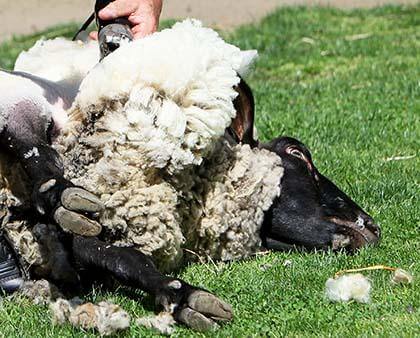By Connor Adams Sheets
Queens Zoo became a living classroom for dozens of Queens children Saturday afternoon as the institution’s barnyard section opened its stables for a real-live sheep shearing.
The event has become one of the biggest annual events at the zoo, officially known as Wildlife Conservation Society’s Queens Zoo, because it provides a rare chance for city kids to become acquainted with the animals they rely on for daily household items like wool clothing and hand lotion.
The shearing this year — the 19th for the event — was as usual even more satisfying for the zoo’s 15 sheep, which finally get to lose the 6 to 15 pounds of wool they carry throughout the winter and feel the cool air on their skin once again.
Tom Hurtubise, curator of education for the zoo, said the shearing is a unique experience that puts people back in touch with where their food and products come from. Most people know that woolen yarn comes from sheep, but it may take a trip to a zoo to learn that a key ingredient in many skin care products is lanolin, a waxy substance secreted by sheep.
“We have to do the shearing anyway, but we’ve turned it into an event because it’s a great way to teach people about the importance of domestic animals in our lives,” he said. “It gives kids a chance to see where their sweaters come from.”
After the two days of shearing are completed some of the wool gathered is given to the zoo’s pumas, coyotes and other predators as “enrichment,” Hurtubise said, meaning that when it is introduced to their environments it reminds them of hunting in the wild and keeps them active and in touch with their wild sides. The rest is given to people who knit it into useful items, which are then donated to the needy.
Benedict Agiamoh, a 5-year-old Corona resident, came to the shearing event with his father.
“They shaved the wool off and now the sheep’s clean with no wool,” he said. “This is my first time seeing a sheep. The cool part was when it tried to escape from the man.”
The man Agiamoh spoke of is Peter Sepe, the professional shearer who cut off the sheeps’ wool Saturday and Sunday afternoon. He struggled to keep the large mammals down and still while he ran an oversize electric shaver over their entire bodies, leaving them much less bulky and weighed-down.
“We hope kids learn where wool comes from, where lanolin comes from,” he said. “A lot of these kids come from a background where they eat lamb or goat as part of their traditional cuisine, but they couldn’t recognize it on the hoof. They come here and they learn what a sheep looks like in the field.”
Reach reporter Connor Adams Sheets by e-mail at csheets@cnglocal.com or by phone at 718-260-4538.


































